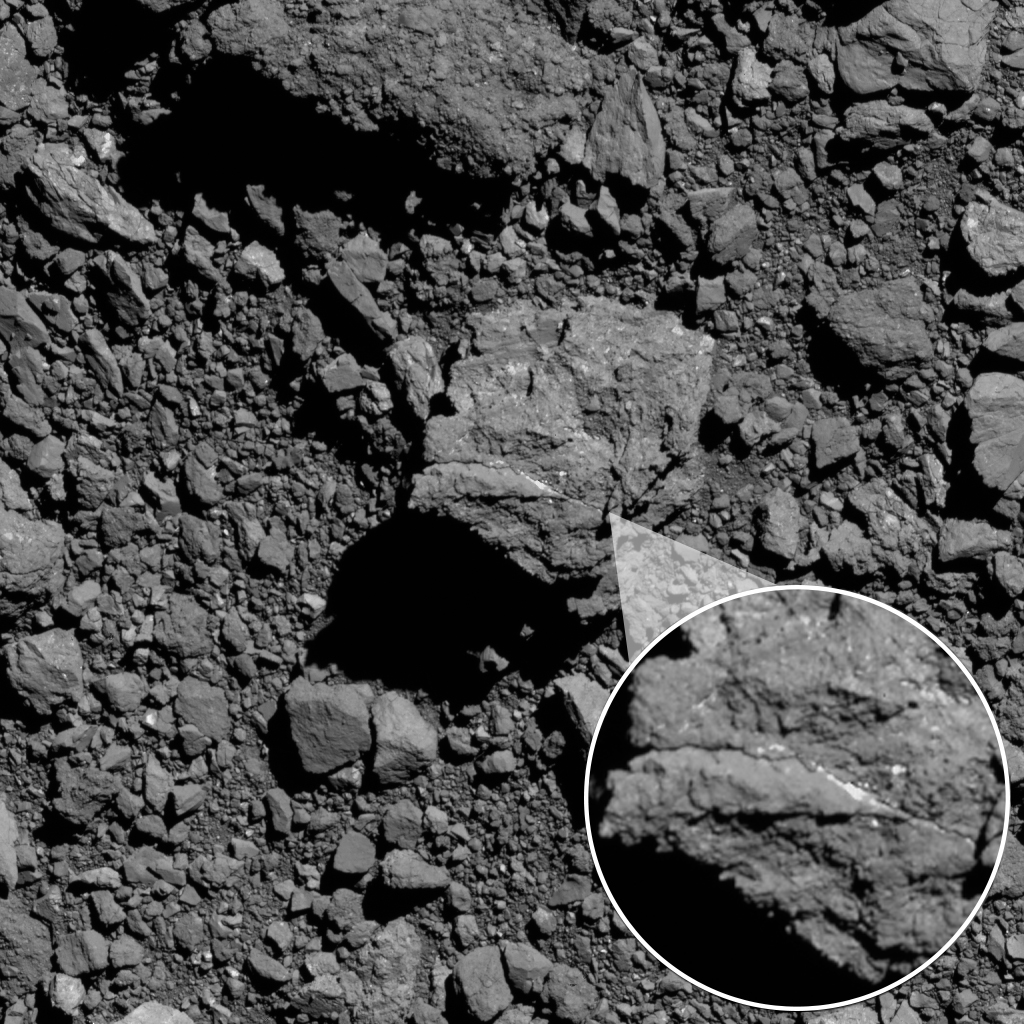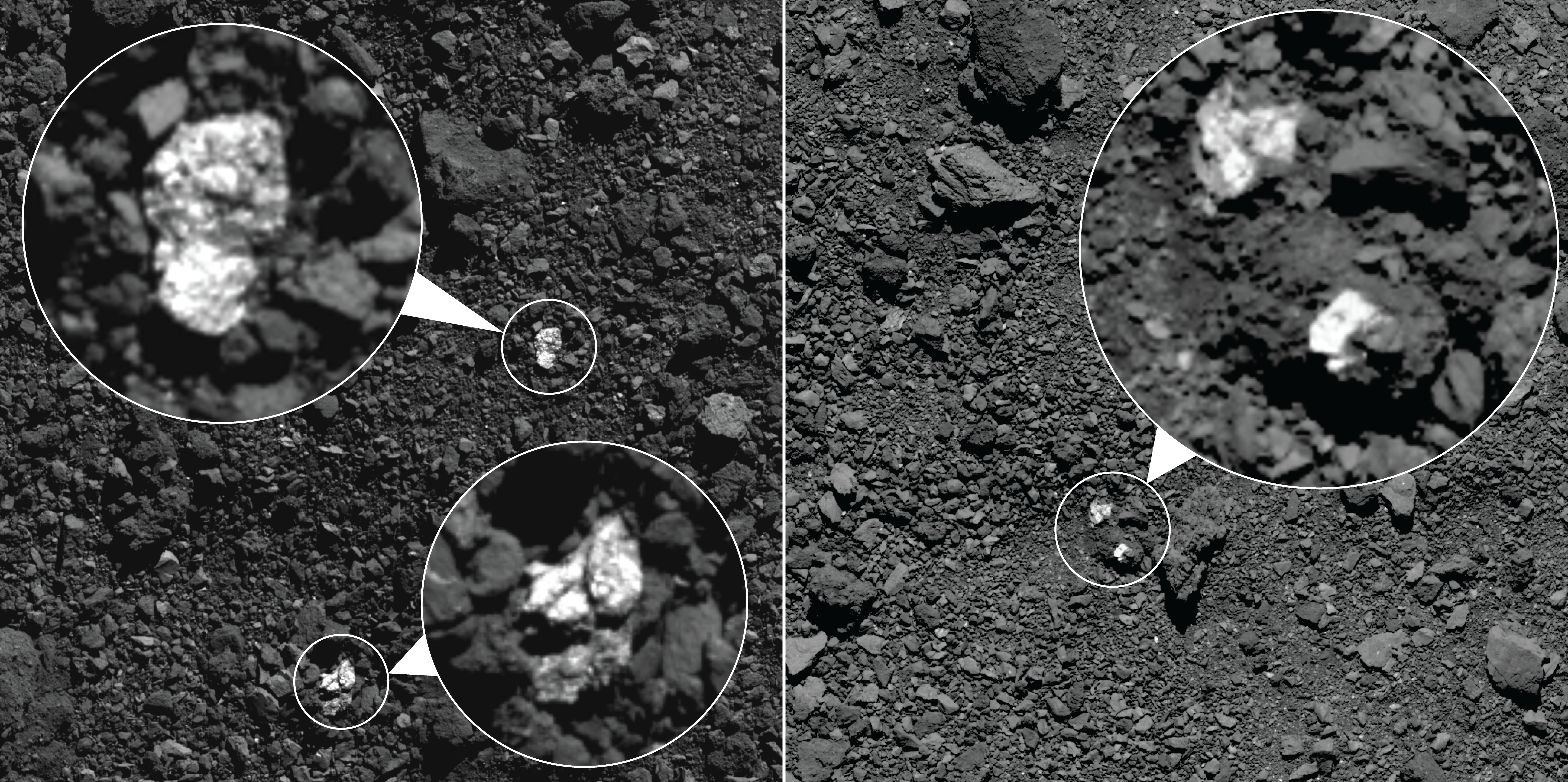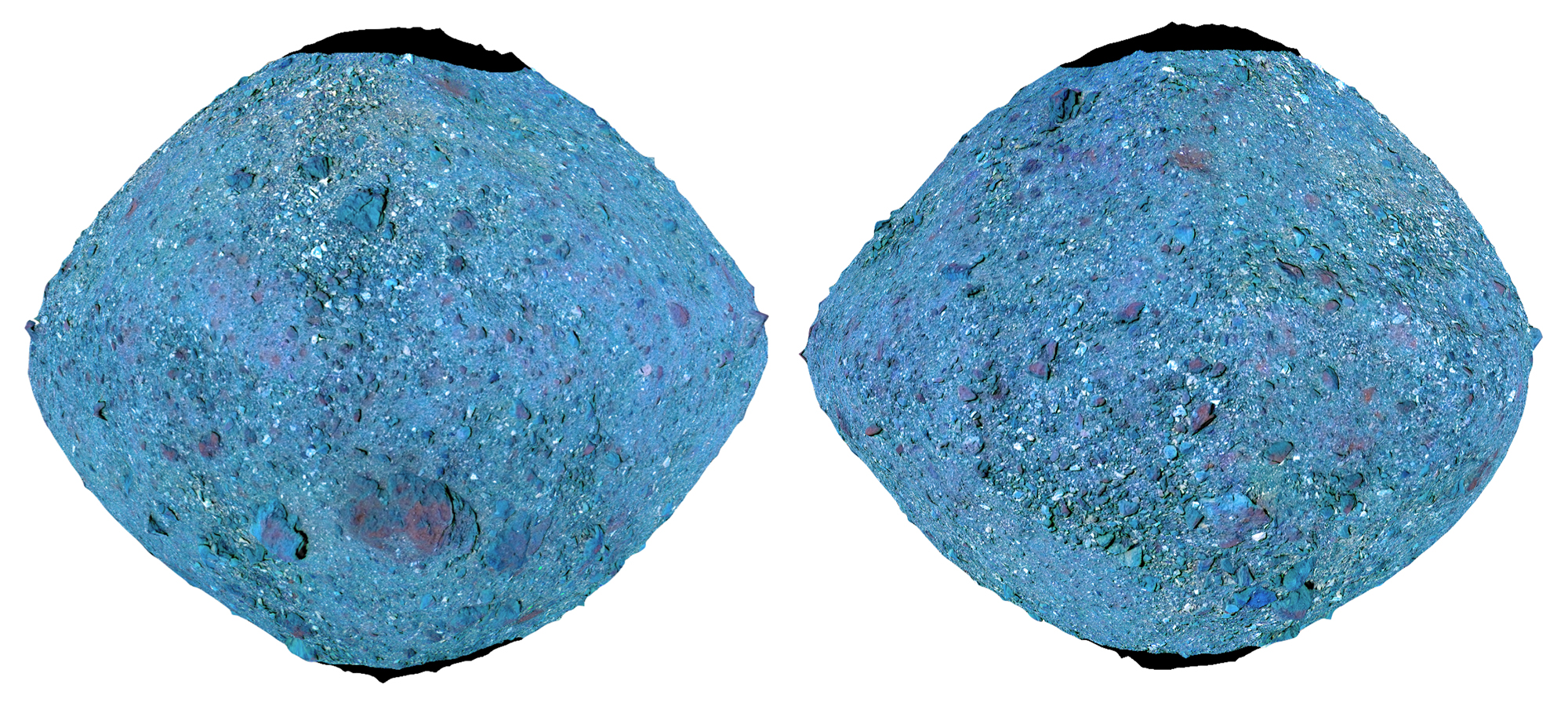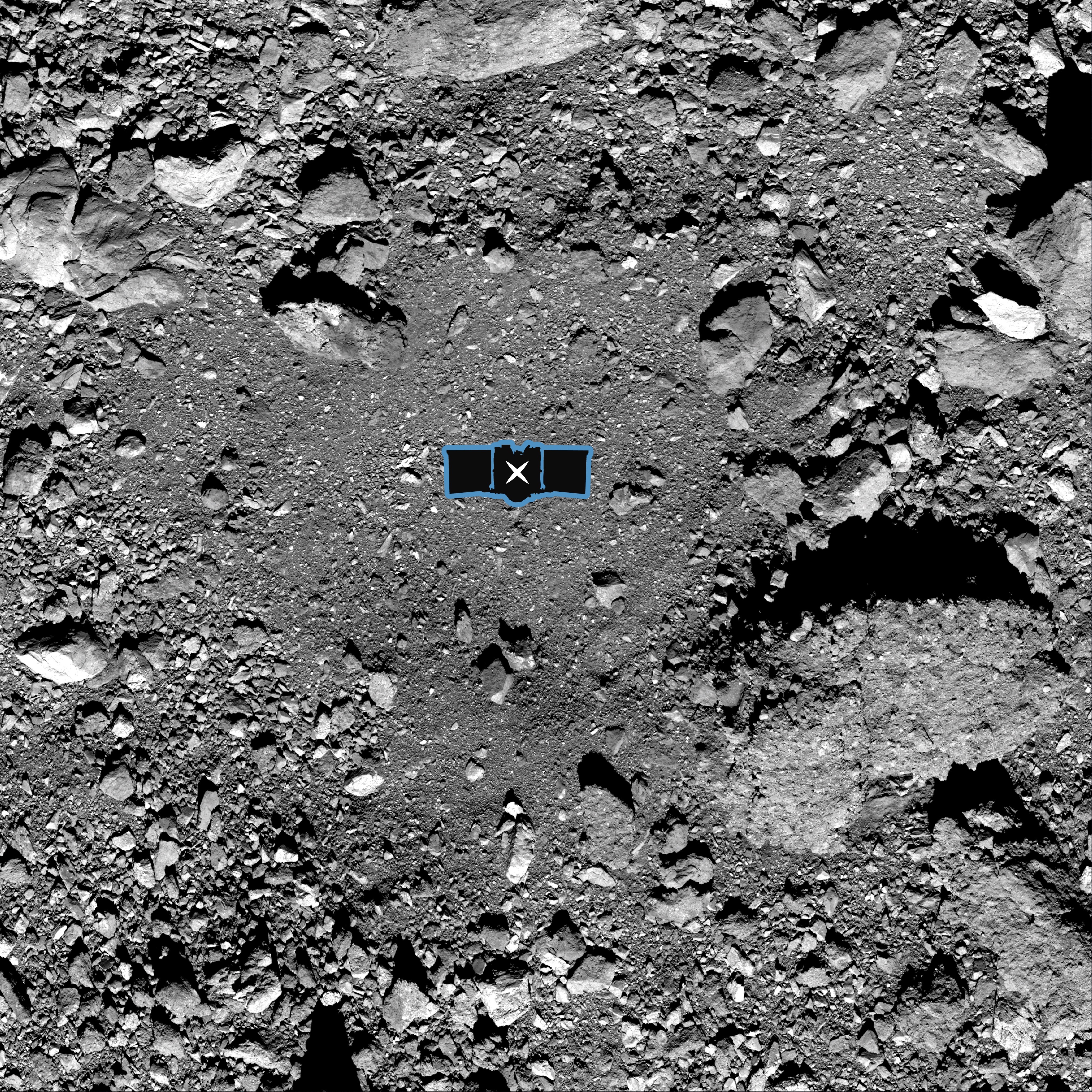Boulders on asteroid Bennu shed new light on the space rock's history
NASA's OSIRIS-REx spacecraft will collect a sample from the asteroid's surface later this month.
The near-Earth asteroid Bennu continues to reveal its secrets to NASA's OSIRIS-REx mission, which has been orbiting the space rock for nearly two years.
New research reveals veins of carbonite materials in Bennu's boulders, as well as signs of organic minerals widespread across its surface. The variety of rock compositions on the asteroid's surface, the gravity of the asteroid, and the unbalanced, diamond-shaped structure of the asteroid's body suggest that Bennu formed after the collision of two parent asteroids, the study found.
Altogether, the new results provide a baseline for the samples that OSIRIS-REX will collect from Bennu's surface on Oct. 20. The spacecraft is expected to bring those samples back to Earth in 2023, if all goes according to plan, and will reveal not only insight about the asteroids that pass near our planet but also a glimpse of the first ten millions years after the sun’s formation.
Video: Asteroid Bennu - Up close and personal in new NASA tour
Related: OSIRIS-REx: NASA's asteroid sample-return mission in pictures

In the process of building planets, the early solar system also created a lot of little debris that would never become a world. These leftovers have many of the same signatures of planetary building blocks but just didn't quite make it into the finished product. Many of these drifted to the asteroid belt, though some were hurled back towards Earth early on to deposit water on the surface of the then-dry planet.
"Because it migrated from the main asteroid belt into an Earth-crossing orbit, Bennu is a prime example of how material could have been delivered to the early Earth from farther out in the solar system," Amy Simon, a researcher at NASA's Goddard Flight Center in Maryland, told Space.com in an email. Simon is the author of one of six papers on Bennu published today (Oct. 8) in the journals Science and Science Advances.
"The widespread evidence of both carbonates/organics and hydrated minerals on Bennu bolsters the argument that asteroids and comets may have brought the needed building blocks for life here to Earth and other planets," she said.
Get the Space.com Newsletter
Breaking space news, the latest updates on rocket launches, skywatching events and more!
Bennu's boulders
Over the last two years, OSIRIS-REx has collected enough images of Bennu to map the asteroid's surface. Variations in the color and albedo (brightness) provide insights into the asteroid's "skin," as well as revealing how it changes over time.
Bennu is considered a rubble pile asteroid, gravitationally coalescing after something slammed into its original parent body. By comparing the differences in color and albedo in the boulders and craters, scientists were able to determine that the asteroid is made up of two distinct populations of boulders.
According to Daniella DellaGiustina, a planetary scientist at the University of Arizona, the leading hypothesis for the appearance of these separate populations is that the original asteroid contained several separate zones that underwent distinct geological processes. When Bennu drew together after the impact that shattered that object, it gathered material from at least two of those zones, DellaGiustina told Space.com.
OSIRIS-REx has also spotted several small boulders with compositions similar in many ways to the asteroid Vesta, the second largest object in the asteroid belt. Those boulders may provide insights into the object that shattered Bennu's parent body. "We think these rocks originated from a fragment of Vesta that collided with Bennu's parent body and were also inherited when Bennu formed," DellaGiustina said.

Bennu also has a surprising amount of carbon-rich materials, including carbonates and organic materials. Carbonates are inorganic minerals, while organics contain carbon in more complex forms. Mapping the wavelengths of light bouncing off of Bennu can provide hints about its composition. Previous observations had already revealed the presence of hydrated phyllosilicates, or clays, on the asteroid's surface. Now, the new research reveals that organic and carbonate materials cover Bennu's exterior.
According to Simon, Bennu carries a wide mix of signals that could be the result of compositional variation, weathering differences, age differences, a variety of particle sizes, or some combination of all of them.
"While a global spectrum of an asteroid may show you one dominant characteristic, it's likely that all asteroids have variation on their surface, too," Simon said. That may explain why complex C-type asteroids associated with Bennu have a diversity of signatures.
"The true test will be analyzing the returned Bennu samples and seeing exactly how the particles vary," Simon said.
Another team of researchers explored the physical characteristics of Bennu's boulders using thermal infrared data to determine their surface roughness and thermal inertia (the measure of how slowly an object's temperature changes), both of which are used as proxies for the physical characteristics of a planetary surface.
Working with his colleagues, Ben Rozitis of The Open University in the United Kingdom found that Bennu's boulders could be classified into two types by strength. The weakest of these boulders would be unlikely to survive a fall through a planet's atmosphere, suggesting that any meteorites of that type that were hurled towards Earth would never survive to reach the ground. The weak boulders have a low reflectance and a hummocky texture, and a lower thermal inertia than C-type asteroids.
The stronger boulders are more reflective, with angular sides and evidence for water-rich mineral deposits in their cracks. Although these boulders also have a lower thermal conductivity than similar meteorites, their numbers come close to the measurements of CM-type asteroids taken in the laboratory.
Rozitis and his team concluded that other near-Earth objects likely contain boulders similar to the ones found on Bennu, rather than the smaller, fine-grained regolith. They also suspect that the samples of material collected by OSIRIS-REx and returned to Earth will contain pieces of the boulders that would not otherwise survive a fall through the atmosphere.
"We therefore expect OSIRIS-REx to return for analysis material that is not currently in Earth's meteoritic collection," the authors wrote in their paper.

The map also revealed that Bennu's surface is weathering in a surprising way. Exposure to the charged particles streaming from the sun and the rain of micrometeorites can have important effects on space rocks. On the moon and other asteroids, scientists have found that their impact darkens the surface, causing it to reflect sunlight in longer wavelengths. But Bennu is doing something unexpected. Instead, the asteroid is growing brighter over time, its rocks reflecting shorter wavelengths of light.
"Something about Bennu is quite different than other planetary surfaces we've observed," DellaGiustina said.
In the early days of the solar system, when it was a scant few million years old, heat from radioactive elements melted water ice, allowing it to interact with and change the rock of the parent body. The rapid decay of those elements means that the alteration had to happen early before the collision that destroyed Bennu's parent body.
That water most likely created the ribbons of minerals seen in some of Bennu's boulders. Similar veins are seen in meteorites, according to Hannah Kaplan, also at Goddard, but they range from microns to millimeters in length and width, while Bennu's veins are 3 to 15 centimeters wide and up to 1.5 meters long. "The veins on Bennu are therefore much larger than any meteorite example we have," Kaplan says.

Although OSIRIS-REx hasn't spotted any vein-bearing boulders in Nightingale, the anticipated sampling region, Kaplan says that doesn't rule out the possibility of smaller, carbonate-rich fragments. She anticipates seeing evidence of carbonate in the material returned to Earth.
Although Bennu shares several compositional traits with CM and CI meteorites, Kaplan and her colleagues found that the dominating material in the fractures was different from known meteorites. It's possible that looking at Bennu from far away reveals different features than those captured in individual meteorites. It's the difference between examining a mountain or a boulder on that mountain; Bennu is looking at the mountain, while meteorites are more like individual boulders.
"From a single boulder, you can get a lot of information — the mountain is mostly granite, it's so many years old — but you might miss the fact that there are trees nearby, too," Kaplan says.
Related: Eruptions on asteroid Bennu hint at causes of space rock explosions
Young and old
Bennu's rubble-pile formation gives it a top-like shape. As the material drew together gravitationally, it began to rotate. The resulting asteroid bulges in the middle and is thinner at the poles. Bennu also has four ridges evident in its northern hemisphere, running from north to south.
In addition to mapping the surface, OSIRIS-REx scientists were also able to create a 3-D model of Bennu down to a resolution of 20 cm (8 inches). Two of the ridges were found to extend through the equator and into the high southern latitudes, and portions of all four are present in the south. In the southern region, material covers the ridges, rendering them invisible to the naked eye.
The northern and southern regions also have different low-albedo areas. South of the equator, the wide-scale darker features occur in the transition between the sloped southern cap and the flatter equatorial region. In the northern features, fewer such regions exist, and most are associated with scattered material identified as rock slides or falls.
"The differences we identified between the northern and southern hemispheres of Bennu suggest fundamental differences in the surface properties and subsurface structures," the authors, led by Michael Daly, a planetary scientist at York University in Canada, wrote in their paper.
The vanishing ridges may indicate a wedging rotational failure in Bennu's history. As the spinning material collapsed down, the material that made up the ridges remained essentially whole, refusing to crumble. Their formation would have led to topographic changes that further impeded disruption, occurring either as the asteroid reaccumulated after the initial collision or later in its lifetime. In the southern hemisphere, large boulders kept material from spreading out, while in the northern hemisphere their relative paucity allowed the material to move and expose the ridges.
Last year, researchers announced that Bennu was blowing dust off of its surface. Led by Daniel Scheeres, of the University of Colorado, Boulder, the researchers used this blown off material, along with the spacecraft itself, to track Bennu's gravity. By modeling how both felt the tug of gravity, the researchers were able to indirectly probe the interior of the asteroid. The dust and rocky satellites revealed that Bennu has a wide variety of material inside of it that pulls differently at orbiting objects depending where they are related to the asteroid's surface. The regions at the equator and center are less dense than the material at its poles.
Previously, researchers suggested that the equatorial bulge could be the result of its spin, as material migrates towards the equator and settles there. Gravitational observations confirm this is the case. It also suggests that the migrating material is more porous than the surrounding material, causing a lower density even as more material settles.
The center of the asteroid is also low-density, and its formation has previously been suggested to be the result of its rapid 4.3-hour spin. By comparing the spin rate of Bennu today with the proposed spin required to transform it from a pile of rubble into an asteroid, the researchers determined that the center, which has a lower density than anticipated, may have formed early in the life of the asteroid. The size of the bulge and underdense region, both consistent with a period of rapid rotation when Bennu lived in the main belt, contrast with the recent origin of the equatorial ridges.
"The mass distribution of Bennu, based on analysis of the measured gravity field, has signatures of both currently active processes and of an ancient event," Scheeres and his colleagues wrote.
Follow Nola on Facebook and on Twitter at @NolaTRedd. Follow us on Twitter @Spacedotcom and on Facebook.
Join our Space Forums to keep talking space on the latest missions, night sky and more! And if you have a news tip, correction or comment, let us know at: community@space.com.

Nola Taylor Tillman is a contributing writer for Space.com. She loves all things space and astronomy-related, and enjoys the opportunity to learn more. She has a Bachelor’s degree in English and Astrophysics from Agnes Scott college and served as an intern at Sky & Telescope magazine. In her free time, she homeschools her four children. Follow her on Twitter at @NolaTRedd
-
rod This is an interesting asteroid report. I read some others. https://skyandtelescope.org/astronomy-news/osiris-rex-oldest-rocks/, https://solarsystem.nasa.gov/asteroids-comets-and-meteors/asteroids/101955-bennu/in-depth/Reply
Here are some observations from me on this asteroid. From the Sky & Telescope report I gathered this impression and content. My observation, a few millions years after solar system formed. 4.568E+9 - 3E+6 = 4.565E+9 years ago. 4.565E+9 years ago there was flowing water. 1.5E+9 years ago, a catastrophic collision. So we have 4.565E+9 - 1.5E+9 = 3.065E+9 years of orbital history from when the water was flowing to the catastrophic collision date.
From the NASA site report on Bennu, to explain Bennu we have formation 4.5E+9 - 10E+6 = 4.49E+9 years reported in the NASA site and whatever postulated events are needed in the model, including moving inwards from the main asteroid belt to just near 1.13 AU today, so a migration of 2 AU perhaps or more. In a period of 4.5E+9 years, Bennu could complete 3.75E+9 perihelion passages of the Sun using a period of 1.2 years. The explanation of this asteroid and features presents a very large extrapolation for its past based upon limited observations and its current orbit and position, likely does not extend back 4.5 billion years ago but only more recently in the solar system. -
Geomartian Replyrod said:The explanation of this asteroid and features presents a very large extrapolation for its past based upon limited observations and its current orbit and position, likely does not extend back 4.5 billion years ago but only more recently in the solar system.
The picture above shows that a large chunk is missing from the Martian moon Phobos.
Bennu was never a part of the main belt asteroids.
Clay is incredibly rare unless you are talking about an origin from a planetary body. There are plenty of types of igneous rocks that can turn into clay on Earth. Except those rocks usually do not form clays until they are close enough to the surface to contact surface moisture. A lot of terrestrial rocks (including igneous) would be considered “wet” by asteroid standards yet these processes do not occur.
The spitting rocks of Bennu are likely steam explosions from hydrated materials. The University of Arizona probably has data indicating this and neglected to mention it.
Bennu is a very young asteroid if the hydrated materials on its surface are still experiencing steam (or any kind of volatile) explosions. Mars has an abundance of hydrated rocks and has a relatively shallow gravity well. This would suggest that Mars or maybe Phobos was the origin for these hydrated materials.
The orbit shown below does suggest that Mars was the origin for the rubble that would become Bennu.
-
Torbjorn Larsson Replyrod said:In a period of 4.5E+9 years, Bennu could complete 3.75E+9 perihelion passages of the Sun using a period of 1.2 years. The explanation of this asteroid and features presents a very large extrapolation for its past based upon limited observations and its current orbit and position, likely does not extend back 4.5 billion years ago but only more recently in the solar system.
From one of your own references:
Half-kilometer Bennu is likely a chip off that planetesimal block, formed from the debris in a catastrophic collision that happened some 0.8 to 1.5 billion years ago. It probably belongs to one of either the Eulalia or Polona asteroid families, both of which originated in collisions at about that time, says Daniella DellaGiustina (University of Arizona). Then, sometime between a few million and a few tens of millions of years ago, gravitational interactions with the giant planets and long-term interactions of solar radiation with spinning bodies shifted Bennu to its current near-Earth orbit.
That migration through the asteroid belt allowed Bennu to collect additional rubble from other sources, such as the six Vesta-like boulders reported in Nature Astronomy.
https://skyandtelescope.org/astronomy-news/osiris-rex-oldest-rocks/ ]
So no, the asteroid isn't all that old, but the material that it consists of has a history starting at the formation of the solar system that scientists are digging into. I wouldn't take the formation pathways too seriously as they will likely change as more data is gathered (as we know is the intention). But the datings are precise, and the broad water veins suggest a large parent body. -
Torbjorn Larsson ReplyGeomartian said:
Bennu was never a part of the main belt asteroids. ...
Bennu is a very young asteroid if the hydrated materials on its surface are still experiencing steam (or any kind of volatile) explosions. Mars has an abundance of hydrated rocks and has a relatively shallow gravity well. This would suggest that Mars or maybe Phobos was the origin for these hydrated materials.
The orbit shown below does suggest that Mars was the origin for the rubble that would become Bennu.
The found origin material suggest that the prior likely origin of the main asteroid belt is an even better posterior, and a Mars origin would not explain the Vesta material pick up. In any case the existence of a competitor to an idea means quantification - such as corresponding materials and origin ages - must be used to settle the case.
Earth crossing asteroids have complex histories including many disturbances, making the resulting orbits rather uninformative of the origins.
Picking a crater among the many in the system - lots of bodies would have had flowing water after system formation - isn't more than eager pattern search. The Stickney crater could be < 0.5 Gyrs old, so would be much too young to explain a 0.8 - 1.5 Gyrs old asteroid.
In view of how crater-counting is unworkable for age-dating Stickney Crater we conclude an alternate age for Stickney Crater of 0.1–0.5 Ga that is constrained instead by the boulder evidence of Thomas et al. (2000), the boulder destruction rate analysis of Basilevsky et al. (2013, 2015), and the observed space weathering of Phobos regolith (Cipriani et al., 2011; Pieters et al., 2014).
https://www.sciencedirect.com/science/article/abs/pii/S0032063315300489 ]
Of course, such a dating is a bit precarious, but not as precarious as suggesting that Phobos is the main suspect for the Benny parent body. -
rod In post #4 we read "But the datings are precise..." That is one interpretation. I did not see radiometric ages published for Bennu, CRE ages, yet the current orbit and position is not long lived. I do see reports like this though, "The current properties of small bodies provide important clues to their origin and history. However, how much small bodies were processed by past collisions and to what extent they retain a record of processes that took place during the formation and early evolution of the Solar System is still poorly understood...", Collisional heating and compaction of small bodies: Constraints for their origin and evolution, https://ui.adsabs.harvard.edu/abs/2020Icar..35013867J/abstract, November 2020Reply -
Torbjorn Larsson Replyrod said:In post #4 we read "But the datings are precise..." That is one interpretation. I did not see radiometric ages published for Bennu,
From the article: "In the early days of the solar system, when it was a scant few million years old, heat from radioactive elements melted water ice, allowing it to interact with and change the rock of the parent body. The rapid decay of those elements means that the alteration had to happen early before the collision that destroyed Bennu's parent body. "
Your first comment argued that everything in the article represent "a very large extrapolation" and that we can't know about the "explanation" that far back, but as far as the parent body goes we know its age and its likely place (main asteroid belt) - Bennu itself is younger. The new hypothesis on its parent body would give a fairly conclusive age of Bennu itself since they have two asteroid families from the same body and with consistent dates. But that part would need more confirmation at a guess. -
rod FYI, post #7 has issues. Here is an example, https://ui.adsabs.harvard.edu/abs/2004GeCoA..68.3779D/abstract, 39Ar- 40Ar evidence for early impact events on the LL parent body, Sep-2004. "These meteorites reveal a range of K-Ar ages from ≥3.66 to ≥4.50 Ga, and peak ages from ≥3.74 to ≥4.55 Ga. Significantly, three of the eight chondrites (LL4, 5, 6) have K-Ar ages of ∼4.27 Ga." There are other published reports on meteorite ages younger than the work of Clair Patterson in 1955/1956 that is used as the fixed age reference today for the solar system.Reply
Bennu has no published radiometric age using various isotopes that I have found, no CRE ages published that I can find, and certainly is in its present location and orbit, not a long lived object in the ecliptic relative to Clair Patterson, fixed age for the solar system. In my opinion, the reporting here does feature a very large extrapolation to reconcile different ages found in the solar system. -
Geomartian Any mechanism for Bennu spitting boulders (up to a meter in size) either by volatile release or even rock stress is a short term mechanism. The volatiles or rock stresses are a finite source of energy which are being rapidly consumed. If Bennu were billions of years old, it would now be entirely inactive.Reply
If Mars (or Phobos) had been bombarded by interstellar asteroids like Earth about 13,000 years ago (the Younger Dryas), it would be consistent with the age of Bennu. A recent chance encounter with a cloud of interstellar asteroids is as good as any fiction that NASA or the Houston oil men might come up with.
I don’t see any evidence for two belt asteroids colliding. What I see is a pile of rubble that might indicate an asteroid impact into Martian sedimentary strata. The impact was deep enough to contribute distinct materials from different strata.
Geochronological techniques have the scientific potential to provide dates with high accuracy. But the technology of geochronology was developed for, and by, the oil companies. A bunch of young asteroids might lead people to conclude that they were created by interstellar asteroid impacts. The higher velocity of interstellar asteroids providing the energy for blasting material out of Mars’ gravity well, while producing a modest or magma filled impact crater.
Interstellar Asteroids and their relationship to oil. An explanation for the absence of Interstellar Asteroids in the geological record due to massive scientific corruption in America.









